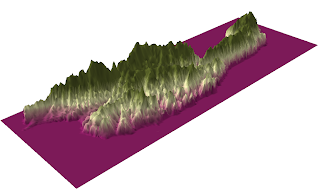Vegetative Regrowth after LA's Station Fire
This paper uses GIS to map and analyze the fire that broke out in August-September 2009 in Los Angeles County. The fire was the 10th largest to break out in LA County since 1933, scorching 160,557 acres (LA Times). A fire of such proportions will inevitably have a strong impact on the local ecosystem. This paper will examine such an impact by mapping the fire expansion zone and "Special Ecological Areas" in LA county to determine if any of these unique ecological areas were burned during the fire, and if so, what it may mean for the process of vegetative regrowth in the area.
Fire Progression
The fire (the majority of which occurred within the Angeles Forest National Park) lasted from August 26 – October 16. In each of the maps below, three dates have been chosen which show three major progressions of the fire (August 29, August 30, September 2, 2009). The Refer to the map below to see the area impacted by the Station fire and a Digital Elevation Model of LA County, showing the fire's progression.
Fire Progression
The fire (the majority of which occurred within the Angeles Forest National Park) lasted from August 26 – October 16. In each of the maps below, three dates have been chosen which show three major progressions of the fire (August 29, August 30, September 2, 2009). The Refer to the map below to see the area impacted by the Station fire and a Digital Elevation Model of LA County, showing the fire's progression.
So what is a "Special Ecological Area"?
Special Ecological Areas are administered by the National Park Service, and they are considered to be "representative ecosystems"; those with natural hydrology, geology and native wildlife, which have been "designated for intensive [environmental] management," such as the control and removal of exotic species (National Park Service). The state of California encompasses hundreds of designated Special Ecological Areas, covering hundreds of thousands of acres. The map to the right shows a close-up of Special Ecological Areas in and around the fire boundaries. The inset map shows all of the Special Ecological Areas within LA County.
Looking at the map below, we see that two separate Special Ecological Areas endured burning, and that the total acreage affected is : 4,072 acres.
What will that mean for vegetative regrowth in these sensitive areas?
Well, fortunately, the native flora found in these Special Ecological Areas are designed to withstand and thrive with fire. In fact, within weeks after the Station fire, the hardwood trees and shrubberies started to regrow from their roots. However, the softwood trees (ie. pines and furs) will take much longer to re-establish themselves (Stefaan Lhermitte, et al.). Softwood trees require heat to open the cones and release the seeds. In fact, many native flora to Southern California require heat for seed germination to occur. If there is adequate water moisture, we should even see many wildflowers blooming in the areas next Spring (J. Timothy Tunison, et al.).
Moreover, seeds that have been lying dormant for years have now been exposed to sunlight, which will help them to germinate, creating new growth. Ash from the fire will also have a positive impact; for ash provides phosphorous, which is a necessary part of fertilizer, stimulating strong roots and blooms (National Science Foundation). Burrowing animals, which mostly survived the fire, churn the ash into the soil, helping the ash penetrate the mineral-poor soil. The years after a fire often show the most beautiful and spectacular vegetation because of all of these factors coming into play, creating a very lush and healthy vegetation.
Main Impacts of Station Fire on Vegetation
The main problem with vegetative regrowth is the loss of conifers in the forest because they must now struggle as seedlings (Stefaan Lhermitte, et al.). They will take a few decades probably to be fully replaced. Also, many animals will have trouble finding food if the species of plants and trees that they eat are having trouble regrowing. Seedlings always have trouble growing because they are weak and preyed upon by animals such as deer. If there is a drought, the seedlings will have trouble as well.
Overall for vegetation, fire can bring new life and growth to the forest, but it is also very detrimental. The LA County Station fire was a huge fire that may have burned a relatively small acreage of Special Ecological Areas, but still had an immense impact on other vegetative areas, let alone populated areas, and we will continue to see its effects many years into the future.
California's Vegetation
In the map below, we can see many different types of vegetation in California. In the LA County region, we see that the main types of vegetation are: chaparral, lower Montane, California grassland, and juniper pine woodland.
California's Vegetation
In the map below, we can see many different types of vegetation in California. In the LA County region, we see that the main types of vegetation are: chaparral, lower Montane, California grassland, and juniper pine woodland.
| Taken from Humboldt State University Library, 22 November 2010: http://www.californiaherps.com/images/vegetationmapjeaster.jpg |
References
Ari B. Bloomekatz and Carla Rivera, "Canyons become battleground in Station fire." LA Times, September 2, 2009.
J. Timothy Tunison and Charles P. Stone. "Special Ecological Areas." Hawaiian Ecosystems at Risk Project. Accessed November 20, 2010. http://www.hear.org.
National Park Service. "Special Ecological Areas: Priority Places for Intensive Management." Last modified 12 June 2001. http://www.nps.gov/archive/redw/sea.htm.
National Science Foundation. "Rising from the ashes: Forest fires give way to new growth." Last modified 18 May 2007. http://www.sciencebuzz.org/buzz_tags/forest_regrowth.
Stefaan Lhermitte, et al., "Assessing Vegetation Regrowth after Fire Based on Time Series of Spot Vegetation Data." IEEE Xplore (2007). Accessed November 19, 2010. http://ieeexplore.ieee.org
| Big Meadow fire, August 27. Taken from Wildfire Today, 22 November 2010: http://wildfiretoday.com/2009/08/page/2/ |










